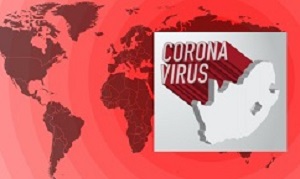South Africa, with 13 imported coronavirus cases, currently fits the World Health Organisation's Transmission Scenario Two. Dr Richard Kaplan, writing for MedicalBrief, outlines decision-making and management options for local medical practitioners.
Kaplan writes:
The latest World Health Organisation (WHO) COVID-19 situation report dated 10 March 2020 states that five new territories (Brunei Darussalam, Mongolia, Cyprus, Guernsey and Panama) have reported cases of COVID-19 in the past 24 hours. Over 100 countries have now reported laboratory-confirmed cases of COVID-19.
Worldwide 119,663 cases have been reported with 4,293 deaths. Currently the main increases in the epidemic are occurring in Italy, Spain, France, Iran, the USA and South Korea with China controlling spread of infection with 20 new reported cases and 17 new deaths in 24 hours.
And on Wednesday, March 11, the WHO reluctantly declared a pandemic with its Director-General Tedros Adhanom Ghebreysus saying, "Pandemic is not a word to use lightly or carelessly".
South Africa currently has 13 confirmed cases – with an unspecified number of contacts in self quarantine. To date all cases have been imported with no reports of community acquired COVID-19.
While it is concerning that COVID-19 has arrived in South Africa, this is not unexpected and should be managed with testing of suspects and containment with isolation for infected individuals and self-quarantine for contacts. China has demonstrated that the epidemic can be contained though the global increase in cases outside of China may be an indication that this may not be easily replicated elsewhere.
An editorial in The Lancet has the following to say on the global spread of COVID-19: “As the window for global containment closes, health ministers are scrambling to implement appropriate measures to delay spread of the virus. But their actions have been slow and insufficient. There is now a real danger that countries have done too little, too late to contain the epidemic.
By striking contrast, the WHO-China joint mission report calls China's vigorous public health measures toward this new coronavirus probably the most “ambitious, agile and aggressive disease containment effort in history”.
The WHO has developed detailed guidelines for appropriate country responses. These are based on four transmission scenarios for COVID-19 namely:
- Countries with no cases (No cases);
- Countries with 1 or more cases, imported or locally detected (Sporadic cases);
- Countries experiencing cases clustered in time, geographic location and/or common exposure (Clusters of cases);
- Countries experiencing larger outbreaks of local transmission (Community transmission).
South Africa, with 13 imported cases, currently fits transmission scenario two. In this scenario, the country aim should be to stop transmission and prevent spread through community engagement, active case finding, self-quarantine of contacts, enhanced infection control and testing of suspect cases per WHO case definition. The South African National Institute for Communicable Diseases has published criteria for identifying and testing a potential SARS-CoV-2 infected person, termed a Person Under Investigation (PUI) meeting the following criteria:
Persons with acute respiratory illness with sudden onset of at least one of the following: cough, sore throat, shortness of breath or fever [≥ 38°C (measured) or history of fever (subjective)] irrespective of admission status and in the 14 days prior to onset of symptoms, met at least one of the following epidemiological criteria:
Were in close contact with a confirmed or probable case of SARS-CoV-2 infection;
or
Had a history of travel to areas with local transmission of SARS-CoV-2;
or
Worked in, or attended a health care facility where patients with SARS-CoV-2 infections were being treated
or
Admitted with severe pneumonia of unknown aetiology.
Both WHO and the NICD guidelines are available online to assist decision making and management.
And while a new untreatable disease with a potentially fatal outcome is alarming, a rational response is desirable. Or as Dr Robyn Reed who diagnosed South Africa’s first case of COVID-19 and is currently in self-quarantine says: "This is hugely blown out of proportion. People are making a huge hysterical panic about something that is a very bad flu. Most of the people who are going to get it, will get over it like they get over the flu.”
While this is perhaps an optimistic assessment for a novel viral infection with a WHO estimated case fatality rate of 3.4%, there is probably some truth in it. It is exceptionally difficult to accurately determine case fatality rates at the early stage of an epidemic. It is also virtually impossible to quantify asymptomatic infections. This has led to speculation of case fatality rates by epidemiologists and infectious disease experts with a range from under 1% to over 3%.
However there is one scenario that allows for a more accurate estimate of the impact of the epidemic and that is the contained environment of the Diamond Princess cruise liner. Or as explained by Timothy Russell of the London School of Hygiene and Tropical Medicine:
"Collecting detailed epidemiological information from a closed population such as the quarantined Diamond Princess can produce a more comprehensive description of asymptomatic and symptomatic cases and their subsequent outcomes. Based on a preliminary analysis of this data, they have estimated case fatality and infection fatality (including asymptomatic) ratios for COVID-19 on the Diamond Princess as 2.3% (0.75%-5.3%) and 1.2% (0.38-2.7%)."
And if this doesn’t give you sleepless nights, it soon will. Using a web based cross-sectional survey of 7,236 people, Yeen Huang et al assessed the mental health burden in China during the epidemic and found that the overall prevalence of general anxiety disorder, depressive symptoms, and poor sleep quality were 35.1%, 20.1%, and 18.2%, respectively. Compared with other occupational groups, healthcare workers had the highest rate of poor sleep quality.
In South Africa, this is still to come – in the meantime, the most pertinent advice is remain calm, don’t fly and wash your hands.
And read the guidelines!
[link url="https://www.who.int/emergencies/diseases/novel-coronavirus-2019/technical-guidance"]WHO guidelines[/link]
[link url="http://www.nicd.ac.za/diseases-a-z-index/covid-19/covid-19-resources/"]NICD guidelines[/link]
[link url="https://www.who.int/emergencies/diseases/novel-coronavirus-2019/situation-reports/"]WHO situation report (daily)[/link]
[link url="https://www.who.int/docs/default-source/coronaviruse/situation-reports/20200310-sitrep-50-covid-19.pdf?sfvrsn=55e904fb_2"]WHO situation report (10/03/2020)[/link]
[link url="https://www.thelancet.com/journals/lancet/article/PIIS0140-6736(20)30522-5/fulltext"]The Lancet editorial[/link]
[link url="https://cmmid.github.io/topics/covid19/severity/diamond_cruise_cfr_estimates.html"]Diamond Princess Cruise study[/link]
[link url="https://www.medrxiv.org/content/10.1101/2020.02.19.20025395v2"]Mental health survey[/link]

